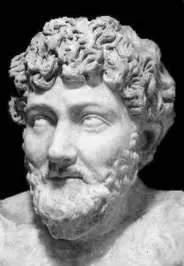This collection of Aesop’s Fables contains translations published by The Paperless Readers Club (Charles W. Eliot (1834-1926) retold by Joseph Jacobs and edited by me), a 1912 book by V.S. Vernon Jones with Introduction by G.K. Chesterton, George Fyler Townsend (1814-1900), and Sir Roger L’Estrange (1616-1704). To the best of my knowledge these translations are in the public domain or freely useable.
Aesop

A great deal of research has been performed relating to Aesop as a historical figure. A statue was even carved that is supposed to represent the man (see figure to the left). Despite this, it’s highly likely Aesop was legendary rather than real.
A number of authors from the 5th century BC onward have placed Aesop at a number of locations and situations. This alone makes it likely that “Aesop” was a name invented to be a generic author for any collection of fables; many such collections from various authors being available.
Fable
There is no historic origin for the fable. They independently arose on both sides of the Euro-Asian land mass dating back to the 8th century BC at least. Around the 6th century BC collections of fables started to circulate widely and this is when the name Aesop first appeared. The Townsend introduction and preface have significant historical information about these collections.
Fables contain a short narrative that seeks to illustrate a hidden message. Generally, fables use animals or objects as part of the narrative yet the message is designed to apply to humans. By doing this, the fabulist is not perceived as the teacher and this reduces any bias the listeners might have against the person.
The fable form both flourished and expanded during the Middle Ages (late 12th century AD). As an example, the tales Roman de Renart tell the story of Renart, or Reynard (the Fox) who was a cunning man. In the 17th century fables were often used for political purposes. In more modern times the fable has become a tool to help children understand moral concepts.
Moral
The moral is the message in the fables. Not all of the translated fables have morals; but, most of this collection does. If no moral was available, I made one up. If a moral was available, I decided if it should be used or one made up from the fable. So, the morals you see at the top of each page and in the index may or may not be the same moral(s) found with the various translations. In all cases, however, if there was a moral with a translation that moral stayed with that translation on the page.